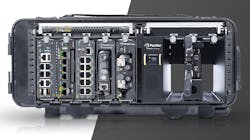Flexible Radio Chassis Fills Gaps in Coverage
Many frequency bands and radio designs are used for civilian and military communications, often causing gaps in the frequency coverage when civilians and different branches of the armed forces must work together in the field. To help fill those gaps, Curtiss-Wright Corp. and its Defense Solutions division have developed the PacStar communications equipment chassis. It's based on a modular open-system approach (MOSA) to accommodate as many radios (and frequency bands) from different vendors as possible.
The open-systems design approach enables interoperability with legacy radio over Internet protocol (RoIP) equipment, mobile ad hoc network (MANET) gear, and other tactical radio equipment. Curtiss-Wright established partnerships with leading radio suppliers to extend the usability of the radio chassis.
The rugged PacStar equipment chassis uses radio brackets to securely mount many different radio designs, including portable and vehicle-mounted radios, and accepts the company’s PacStar model 463 RoIP radio module. The cross-band radio operation eliminates gaps in frequency coverage between different radio systems (see image above).
Chris Wiltsey, senior vice-president and general manager of Curtiss-Wright Defense Solutions division, noted, “A common hurdle, whether in the battlefield or during first responder civil operations, is the communications gap that results from the use of multiple different radio types in the field. Our new PacStar Radio Chassis expands the existing PacStar Modular Radio Center to solve that problem by easing and speeding the deployment of disparate radio types in a compact, rugged common enclosure, with support for the most popular DoD and civilian radios.”
Wiltsey pointed out the value of the expanded interoperability, “Whether a public emergency where police, fire, and other services need to talk with each other, or at the tactical edge where our warfighters need to communicate with coalition forces, radio interoperability helps to ensure mission success.”
Three versions of the PacStar radio chassis are currently available, including powered chassis for three and four radios and an unpowered chassis for four radio modules. Powered chassis include a single-slot, integrated power system capable of running on a wide range of ac and dc power sources. Unpowered chassis host additional radio modules while drawing power from a powered PacStar radio chassis or PacStar modular radio center (MRC) system.
About the Author
Jack Browne
Technical Contributor
Jack Browne, Technical Contributor, has worked in technical publishing for over 30 years. He managed the content and production of three technical journals while at the American Institute of Physics, including Medical Physics and the Journal of Vacuum Science & Technology. He has been a Publisher and Editor for Penton Media, started the firm’s Wireless Symposium & Exhibition trade show in 1993, and currently serves as Technical Contributor for that company's Microwaves & RF magazine. Browne, who holds a BS in Mathematics from City College of New York and BA degrees in English and Philosophy from Fordham University, is a member of the IEEE.
